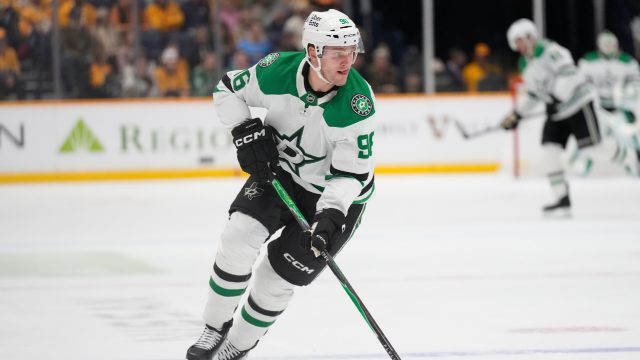
TORONTO — We’ve officially ticked past the quarter mark of the 2025-26 NHL season, and somehow it feels like we know less about what to expect from this season than we did before it all started. The season has gone all pear-shaped.
I’ll explain what I mean with seven takeaways from the 2025-26 season to date below.
Atlantic’s reign of terror is over
On Tuesday night, the Tampa Bay Lightning took down the New Jersey Devils by a score of 5-1. That brought their goal differential on the season out of the negative, and up to plus-three. Before that game, no team in the Atlantic Division had a positive goal differential.
For the past decade, the league has looked to the Atlantic as the home of true Stanley Cup threats, whether it’s been the Florida Panthers, Boston Bruins, Tampa Bay or even the Toronto Maple Leafs, who’ve had some nice regular seasons.
At this point, picking a favourite to win the Atlantic is no different from picking a name out of a hat. Any of the seven non-Sabres teams is a reasonable choice, and, honestly, the Sabres themselves aren’t 100 per cent out of it.
The Detroit Red Wings are in the lead with their even goal differential and nine regulation wins in 20 games. Incredible stuff. That’s not to say one or two of these teams won’t figure it out, but boy, unless Florida gets fully healthy at the right time, that division is anyone’s game.
From there, the rest of the East isn’t much better.
East is a muddled mess
I suppose Carolina gets the nod as the clear Eastern favourite, but it’s also got nine regulation wins in 19 tries, which has led to their modest plus-16 goal differential (modest as far as league leaders goes). New Jersey’s got the same record yet with even fewer regulation wins and sits at plus-5. And the rest of the conference?
I dunno, man.
It’s never been more muddled. A good week and you’re in playoffs, a bad one and you’re in dead last.
I think this is going to change in the years ahead. This extreme parity comes from years and years of the flat salary cap forcing good teams to trade any excess talent they had, while bad teams drafted and drafted and drafted. This is the year the top drops, the bottom finally rises, and it’s all a hodgepodge. After this, good teams should be more capable of keeping their talent, the top dogs will spend, and you’ll see some separation.
But for now, this is anyone’s year — assuming the Colorado Avalanche all contract the plague in late April and don’t win 16 straight in the playoffs.
Avs are not messing around
The Avs have a plus-31 in goal differential in just 19 games, they’ve collected a points percentage of .815, and are truly head and shoulders above whoever you consider to be the next-best team this season. They have captured lightning not in a bottle, but their hands, and they’re using it to shock everyone in their path.
A full year with both Gabriel Landeskog and Valeri Nichushkin helps, and Martin Necas has acquitted himself well there, which combined with finally getting some elite goaltending has made their games awfully one-sided. When you flip to their channel, it’s a different sport than the rest of the muddy middle. So we have league-wide parity, with one clear Cup favourite right now.
Shots are down, save percentage is down, goals kind of level
During the 2021-22 NHL season, the average shot count at the end of each game read something like 32 to 31. The team average eventually settled at 31.4, which was pretty normal, as it was the fifth time in six years the average settled in the 31s.
The next season it went down to 31.1, then to 30.1 in 2023-24, then to 28.1 last year, and this year it sits at 27.7, the lowest total since 2001-02.
We’re talking about a drop of 3.5 shots per team, so seven shots per game, in just a four-year span.
The thing is, in 2001-02, the average save percentage was .908, which meant we saw just 2.62 goals per team, per game.
This season, we’re seeing 3.05 goals per game, just up from last year (and way up from the decade of 2010-20), on the backs of goalies having a collective .897 save percentage.
-

-
Real Kyper and Bourne
Nick Kypreos and Justin Bourne talk all things hockey with some of the biggest names in the game. Watch live every weekday on Sportsnet and Sportsnet+ — or listen live on Sportsnet 590 The FAN — from 4 p.m. to 6 p.m. ET.
To better understand this: coaches have finally come to grips with the fact that “Shoot from everywhere!” was always a dumb strategy, and became particularly dumb when goaltenders started progressing to the level they’re at today.
Shot attempts today are partially seen as forfeiting possession, and you only want to do that if you think you’ve got a reasonable chance to score. It’s the painful overtime strategy we see today dragged into five-on-five hockey.
The attempts that are worthwhile now include shooting from distance through traffic, passing off the pads and other low-percentage shots at times, but mostly it means you aren’t warming goalies up from distance, and you’re waiting until you’re somewhere you can legitimately score from to pull the trigger.
Life has gotten harder for goalies over the past decade and it’s not about to get any easier. Shooters are far better, and since they’re not wasting attempts, every save will be a battle.
Changing of the guard?
I mentioned the bottom of the league rising up, which is something that gets theorized just about every year, but it finally seems to be happening. (Come on Buffalo, catch the wave!)
The Anaheim Ducks are first in the Pacific. The Montreal Canadiens have had a few losses of late, in part due to some tough injuries, but they made playoffs last season and sit within a playoff spot this year too. The Ottawa Senators made the playoffs and are around them again despite missing Brady Tkachuk, and we mentioned Detroit being atop the Atlantic.
The San Jose Sharks are better, the Utah Mammoth are better, the Seattle Kraken are better. This whole rebuilding thing, it’s painful, but it’s a lot easier to justify when the improvements are made, the bandages are off and the team starts to take real strides. (Maybe something for teams like the Nashville Predators, Vancouver Canucks or Calgary Flames to at least consider?)
Youth movement
When Wayne Gretzky and Mario Lemieux left the game, Sidney Crosby and Alex Ovechkin showed up to carry the mantle for the league. We’ve since added Connor McDavid and Nathan MacKinnon, and it looks like the next wave of “faces of the league” have arrived.
On Tuesday night, Macklin Celebrini and Connor Bedard had duelling hat tricks, and now both sit inside the NHL’s top five in scoring, right there with MacKinnon and McDavid (oh, Canada).
Superstars don’t tend to ease their way into the league, and in Year 2 and 3 of their careers, these two fellas are no exception. They’re absolute musts on Team Canada now at the Olympics and sit poised to dominate the NHL’s conversation for years to come.
Olympics have an impact
Olympic hockey teams will be selected on Jan. 1, which means that right now, players are making their cases to be on them. We know beyond a shadow of a doubt that this matters to guys and it’s on their minds. It’s a fun process to follow and hypothesize about.
But the Olympics have also condensed the schedule for teams and there’s an awful lot of injuries league-wide. With injuries, and games more condensed, teams are practicing less, and I’d argue you can see that reflected in the play.
Still, it will be worth it for fans and players alike as we move toward the Winter Olympics in Italy in February.
From there, it will be a sprint for the league: the trade deadline follows shortly after, then the race to playoffs for all these standings-jammed teams, followed by a two-month grind to the finish. It’s only 20 games in for most teams, but with Christmas one month away, and the Olympics looming after, events are going to start unfolding faster from here.






